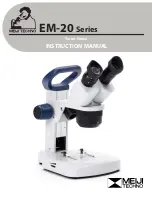
6
+
1
+
Ages Grades
EI-5272
Tip #1
Holding the Pocket Scope:
Be sure the rim of the lens casing
is flat against the surface you are
observing. Slide the eyepiece all
the way into the body of the
Pocket Scope.
Using the Pocket Scope—Microscope
Tip #2
Use a Lot of Light:
Make sure
plenty of light shines on what
you are observing. Be sure it
is shining into the lens casing
from the front. Sunlight is best,
but you can also use a lamp
or flashlight.
Tip #3
Focus:
Focus the Pocket Scope
by sliding the eyepiece away
from the lens. Most objects and
surfaces become clear when you
slide the eyepiece out about
1/4 inch (8mm). That’s about the
width of the fingernail on your
little finger.
Tip #4
Flip the image:
Find a letter e on this page and look at it through your
Pocket Scope. What do you notice? Yes, the e is upside
down and backward. Now turn the page upside down
and look at the e again. What do you notice? Yes, the e
is now right-side up. All things will appear upside down
and backward when you look at them through your
Pocket Scope microscope. So, if you want to look at things
right-side up, just turn the object upside down before
observing it with your Pocket Scope microscope.
Note:
If you wear glasses, it may be easier to use the Pocket Scope by removing your glasses
and looking at objects directly through the eyepiece.
Tip #1
Tip #2
Tip #3
Observe things near and far with your GeoSafari® Pocket Scope.
Try This!
Check out the tiny hairs on your arm using the
Pocket Scope microscope.




















